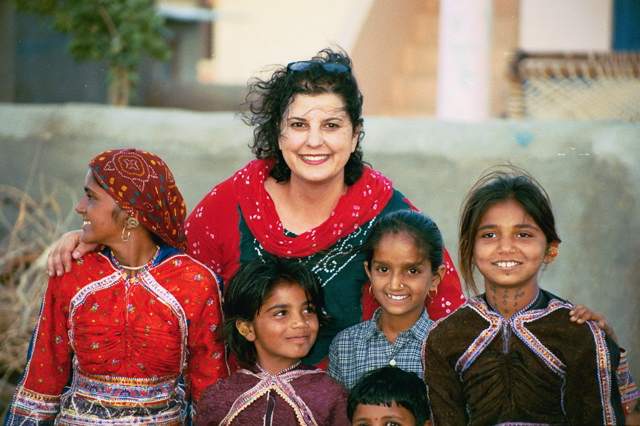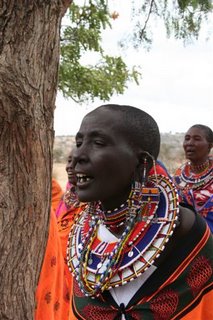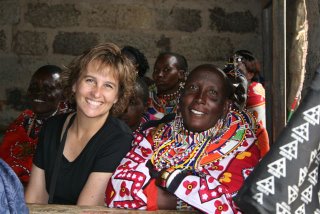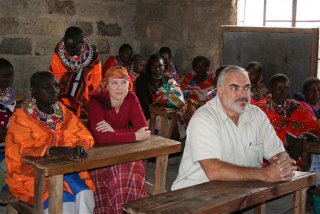 |
BajaliaTrading Places as we take a tour of the Bajalia work around the globe. From Orlando Florida to the ends of the earth - China, Afghanistan, Thailand, India and Africa. BaJalia International is a collaboration of for-profit and nonprofit that partners with artisans and entrepreneurs in undeveloped regions for the purpose of stimulating economic growth, while providing sustainable economic and social benefits to craftspeople. Support us at www.bajalia.com. |
 |
Sunday, September 10, 2006
We are posting our last message to the blog while in Africa. Back in Nairobi leaving for our international flight to Dubai within the next few hours. We are all packed which was no small feat, since we are all taking much more luggage that we brought. We sent some back with Skip already. Many of our new treasures will be seen in our sales coming up later this month. We are looking to schedule more sales for November and early December. Looks like October is pretty packed. We have many new Christmas card designs and will be developing new products from some of the samples. Including some cosmetic bags using fabric from Constance sewn by the women of Avega. So much to do as we begin re-entry but would love to talk to you about having a sale in your area.
Small to Medium Enterprise



 Much of our time in Rwanda was spent with the small to medium size enterprise. This is a sector that is just growing as is the middle class in Rwanda. We visited Charlotte, who has a clothing boutique and hair salon. Languida has a funeral business. And Pierette and Peggy who run a freight forwarding company. We talked to Pierette and Peggy about consolidating our shipments in the region including items coming from Kampala.
Much of our time in Rwanda was spent with the small to medium size enterprise. This is a sector that is just growing as is the middle class in Rwanda. We visited Charlotte, who has a clothing boutique and hair salon. Languida has a funeral business. And Pierette and Peggy who run a freight forwarding company. We talked to Pierette and Peggy about consolidating our shipments in the region including items coming from Kampala.
Kigali Arts and Crafts

 This is Constance displaying her tie and dye. We bought several samples to develop some products using these fabrics. Her eye for color and design is great. Constance is a widow and a single parent. Her husband, who died two years ago, was an artist, as is she and 4 out of 5 of her children. Her shop was in the Kigali artists cooperative complex. Being the sharp business woman that she is, she immediately began discussing my talk about merchandising and space allocation showing me around her shop and telling me what items were the most profitable for her and where she was wasting space. She definitely was listening in the training and was already moving things around. Her passion and desire is to open a womens' cooperative, training them to use this dye process, and she already owns the plot of land and was telling me about her 100 day plan and her success map. We enjoyed seeing her jewelry designs and paper beads made into jewelry. She wants to teach street children a skill and assist to get them off of the street. We talked about vegetable dyes and different dying techniques. We had several ideas for her cooperative that we are taking back to her mentor in the US. These women are amazing and inspiring. They are planning a dinner for us tonight, which we are looking forward to. We couldn't visit each business but hope to next visit.
This is Constance displaying her tie and dye. We bought several samples to develop some products using these fabrics. Her eye for color and design is great. Constance is a widow and a single parent. Her husband, who died two years ago, was an artist, as is she and 4 out of 5 of her children. Her shop was in the Kigali artists cooperative complex. Being the sharp business woman that she is, she immediately began discussing my talk about merchandising and space allocation showing me around her shop and telling me what items were the most profitable for her and where she was wasting space. She definitely was listening in the training and was already moving things around. Her passion and desire is to open a womens' cooperative, training them to use this dye process, and she already owns the plot of land and was telling me about her 100 day plan and her success map. We enjoyed seeing her jewelry designs and paper beads made into jewelry. She wants to teach street children a skill and assist to get them off of the street. We talked about vegetable dyes and different dying techniques. We had several ideas for her cooperative that we are taking back to her mentor in the US. These women are amazing and inspiring. They are planning a dinner for us tonight, which we are looking forward to. We couldn't visit each business but hope to next visit.
The Geonicide Memorial in Kigali
We had another full day, visiting BPeace associates in their places of businesses and photographing them at work. Then off to the Geonocide Memorial to pay our respects to the victims and people of Rwanda. It was something we felt we really needed to do. We saw very graphic displays of video, photography and mass graves. We were all forever changed by what we saw and read and wept with our friends here as we remembered how the world looked away. All of Rwanda was impacted by this crisis of evil. There is no other way to describe what we saw other than evil and humanity at its absoloute worst. There are those that think man is basically good-if they saw what we saw that idea would be forever shattered. We saw coffins stacked in mass graves and photos of children and adults massacred. Rwanda each year beginning in April until July 3 remembers for 100 days the geonicide and the country has learned forgiveness and reconcilliation in ways I could have never imagined. This was the safest country we had ever witnessed here in Africa. At dinner we heard stories of women who married into families that killed their parents. We heard of children taken in and being raised by those that murdered their parents. Mothers that took in the children of those that killed their own kids and are raising them as their own. And the widows the many,many widows we could not believe what we saw.
Thursday, September 07, 2006
The New Hopeful Rwanda


 We are having a hard time imagining such horror in a city so beautiful. The French influence gives Rwanda a refined air and it’s very clean. A refreshing change from other places we have visited. The city sits on many hills, part of the “milles collines” or thousand hills that Rwanda claims, so the view is spectacular from anywhere. And there is a real sense of reconciliation and healing that most here say is only because of God. Our day was spent with the Rwanda Bpeace Associates. A sharp group of women who have a variety of businesses from salons and party stores, to cleaning service and supplies, freight forwarding and funeral services. This was their regular monthly meeting we were so fortunate to be part of. Debbie taught a session on merchandising and space allocation based on profitability which prompted many questions, ideas and creative interaction. Susanne taught on customer service, focusing on being a servant leader; being an example to employees as well as to the customers. She stressed relationship and following up after the sale, or when new merchandise prompts a followup call. Dinner found us at the Hotel Mille Collines, most well known from the movie Hotel Rwanda. Again it was hard to picture the struggles that took place in what is now a 5 star accommodation. Time does seem to heal, but the scars do not disappear.
We are having a hard time imagining such horror in a city so beautiful. The French influence gives Rwanda a refined air and it’s very clean. A refreshing change from other places we have visited. The city sits on many hills, part of the “milles collines” or thousand hills that Rwanda claims, so the view is spectacular from anywhere. And there is a real sense of reconciliation and healing that most here say is only because of God. Our day was spent with the Rwanda Bpeace Associates. A sharp group of women who have a variety of businesses from salons and party stores, to cleaning service and supplies, freight forwarding and funeral services. This was their regular monthly meeting we were so fortunate to be part of. Debbie taught a session on merchandising and space allocation based on profitability which prompted many questions, ideas and creative interaction. Susanne taught on customer service, focusing on being a servant leader; being an example to employees as well as to the customers. She stressed relationship and following up after the sale, or when new merchandise prompts a followup call. Dinner found us at the Hotel Mille Collines, most well known from the movie Hotel Rwanda. Again it was hard to picture the struggles that took place in what is now a 5 star accommodation. Time does seem to heal, but the scars do not disappear.
Genocide - Old Rwanda
Ten years ago, nearly a million Rwandans died in just 100 days when Hutu tribesmen began a campaign of genocide against members of the Tutsi tribe. Rwanda's population is now 56% women, half of them widows. As many as 60% of the women may have AIDS. In the face of such despair,and lost families rebuilding seems a daunting task. We can feel the sense of loss yet at the same time hope is in the air.
Uganda - The Pearl of Africa




 From the desert of Turkana we land in Uganda, just over an hour a way, which is lush with vegetation. Of course we could not go directly we had to go back to Nairobi and fly back up. Then a 3 hour drive brought us to Jinja, a town famous for being at the source of the River Nile. Our time was fruitful during meetings with 5 women’s self help groups. Mama, who they refer to as the leader of this NGO continues with her heart to help improve the lives of women. She along with a minimal staff has founded 100 of these self help groups, along with other creative enterprise including chicken farming. She has facilitated new schools being built and now focuses on a shelter for women. It’s exciting to see the women light up when they hear new ideas like taking their weaving and turning it into belts, or new styles of purses. Or using the paper beads that they make into necklaces, to accent the purses and baskets. They are not only using reeds and banana fiber but recycled bags, too! The creativity is encouraging and with simple changes and suggestions, the women begin to share their own ideas. And when Debbie pulled out the computer to show some designs and products, it really created quite a stir.
From the desert of Turkana we land in Uganda, just over an hour a way, which is lush with vegetation. Of course we could not go directly we had to go back to Nairobi and fly back up. Then a 3 hour drive brought us to Jinja, a town famous for being at the source of the River Nile. Our time was fruitful during meetings with 5 women’s self help groups. Mama, who they refer to as the leader of this NGO continues with her heart to help improve the lives of women. She along with a minimal staff has founded 100 of these self help groups, along with other creative enterprise including chicken farming. She has facilitated new schools being built and now focuses on a shelter for women. It’s exciting to see the women light up when they hear new ideas like taking their weaving and turning it into belts, or new styles of purses. Or using the paper beads that they make into necklaces, to accent the purses and baskets. They are not only using reeds and banana fiber but recycled bags, too! The creativity is encouraging and with simple changes and suggestions, the women begin to share their own ideas. And when Debbie pulled out the computer to show some designs and products, it really created quite a stir.On our way to the villages we stopped by the source of the Nile. Our big sightseeing adventure.
Ordinary Women Extroadinary Missions

 During our first morning in Lodwar we met Elizabeth and her husband Fritz, from Germany. They have been working with the orphans and local children on several levels. Elizabeth soon found, that daily, people were at the gate of her home needing food and help, mostly women. So she challenged them that she would not give out food without getting something in return. Now they come every week with their baskets. Many sizes, shapes and colors that they carefully weave under large shade trees. Elizabeth soon decided that instead of food she would give out money for them to buy their own food. We encouraged Elizabeth and helped with design ideas and opportunities for the women to begin learning the business for themselves. Then we stopped for lunch with some friends. Ally showed us the beautiful cards she is hand painting and decorating along with necklaces, bracelets that include natural seeds, beads and wooden animals. Also she is making beaded key chains. This is helping her to reach the youth in the area with practical skills and opportunities for future sustainability.
During our first morning in Lodwar we met Elizabeth and her husband Fritz, from Germany. They have been working with the orphans and local children on several levels. Elizabeth soon found, that daily, people were at the gate of her home needing food and help, mostly women. So she challenged them that she would not give out food without getting something in return. Now they come every week with their baskets. Many sizes, shapes and colors that they carefully weave under large shade trees. Elizabeth soon decided that instead of food she would give out money for them to buy their own food. We encouraged Elizabeth and helped with design ideas and opportunities for the women to begin learning the business for themselves. Then we stopped for lunch with some friends. Ally showed us the beautiful cards she is hand painting and decorating along with necklaces, bracelets that include natural seeds, beads and wooden animals. Also she is making beaded key chains. This is helping her to reach the youth in the area with practical skills and opportunities for future sustainability.
Turkanaland

 This dry, arid, desert region sits between the borders of Sudan and northern Uganda. From the air it is an endless landscape devoid of civilization until you look closely and see the small thatched huts dotting the landscape. On the ground in Lodwar we find a bustling town of 50,000 that is becoming a business center crossroads, with goods and natural resources coming out of Sudan. Just outside of town you are now in the “bush”. This is the Africa you see in National Geographic. And yet we found a man who has a solar panel outside his hut which is about 5 feet in circumference. Looking inside, he had a radio, light and, yes, a computer! Days are spent herding sheep, donkeys and camels or working in the community garden outreach. Susanne once again is obsessed with the camels, as well as the people.
This dry, arid, desert region sits between the borders of Sudan and northern Uganda. From the air it is an endless landscape devoid of civilization until you look closely and see the small thatched huts dotting the landscape. On the ground in Lodwar we find a bustling town of 50,000 that is becoming a business center crossroads, with goods and natural resources coming out of Sudan. Just outside of town you are now in the “bush”. This is the Africa you see in National Geographic. And yet we found a man who has a solar panel outside his hut which is about 5 feet in circumference. Looking inside, he had a radio, light and, yes, a computer! Days are spent herding sheep, donkeys and camels or working in the community garden outreach. Susanne once again is obsessed with the camels, as well as the people.
Friday, September 01, 2006
Turkana bound
We are flying to the Turkana region which is up next to the border of Sudan. This will limit our ability to post to the blog, but we’ll have great pictures and stories to share as soon as we can. We will be there for two days then back to Nairobi for our commercial flight to Uganda.
A long road through the Serengetti
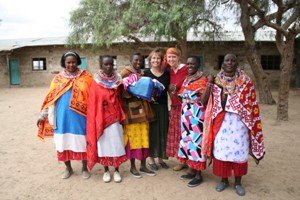
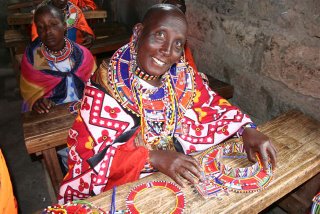 We headed two hours outside Nairobi south east to visit a Maasai village. This village was a pilot project for literacy training. The older women begged for training so they could read a book they were given for themselves. Usually women of this age were not trained in this way, but the desire and determination of this group was amazing. Carol and Emily from AlARM who conducted the program escorted us and it was worth the drive. We were greeted with hugs and kisses from each and every woman. We then were welcomed with a proper Maasai song and dance. They also started a cooperative beading business and impressed us by telling us the prices of the pieces that they had made and actually counting out the change for us. At one time I was told there was not enough money to make change so of course, I bought one more item to make the money balance. Carol had an order that she had to explain to the women for bracelets, which is the first commercial order this group has had. We promised I would go back and design a couple of pieces and email the ALARM office with an order for bracelets and a belt soon. We tried on baubles and were so sorry to be leaving. We had to drag Susanne to the jeep. She is really ready to stay.
We headed two hours outside Nairobi south east to visit a Maasai village. This village was a pilot project for literacy training. The older women begged for training so they could read a book they were given for themselves. Usually women of this age were not trained in this way, but the desire and determination of this group was amazing. Carol and Emily from AlARM who conducted the program escorted us and it was worth the drive. We were greeted with hugs and kisses from each and every woman. We then were welcomed with a proper Maasai song and dance. They also started a cooperative beading business and impressed us by telling us the prices of the pieces that they had made and actually counting out the change for us. At one time I was told there was not enough money to make change so of course, I bought one more item to make the money balance. Carol had an order that she had to explain to the women for bracelets, which is the first commercial order this group has had. We promised I would go back and design a couple of pieces and email the ALARM office with an order for bracelets and a belt soon. We tried on baubles and were so sorry to be leaving. We had to drag Susanne to the jeep. She is really ready to stay.
Kibera Slum Nairobi

 We started our morning on African time all meeting and leaving our hotel for a quick visit to Kibera slum. We have been selling cards from this project for a couple of years and this was our chance for Susanne and others to check it out. We sang, laughed and shopped as well as encouraged the workers. Here you see them making cards, including making the handmade paper. The Christmas cards were ready for our order so we will be bringing those home with us. Kibera slum is the largest slum in the world, and in one small part of it lives are being changed one card at a time.
We started our morning on African time all meeting and leaving our hotel for a quick visit to Kibera slum. We have been selling cards from this project for a couple of years and this was our chance for Susanne and others to check it out. We sang, laughed and shopped as well as encouraged the workers. Here you see them making cards, including making the handmade paper. The Christmas cards were ready for our order so we will be bringing those home with us. Kibera slum is the largest slum in the world, and in one small part of it lives are being changed one card at a time.
The fort next to the old British Embassy
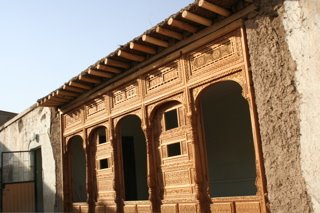
 This was the address we were given to get to Turquoise Mountain Foundation. Just like most the addresses here. Go past the bombed out building, turn past the well, etc. Every time we heard directions we had to laugh, which bombed out building, what well? The effects of the war are still so evident, but ever so often we see a rose garden or beautiful restoration projects such as these. This group is helping revive the ancient arts of woodworking, Herat glass, Calligraphy. Restoring the old tile work and many other projects including restoration of the old Islamic art pieces. President Karzi and Prince Charles are co-presidents of this group. We had tea with Carey an intern from Southern California who is here working on this project and the CEO Rory Stewart. We will keep in touch as our embroidery projects get to the place of documentation and resurgence.
This was the address we were given to get to Turquoise Mountain Foundation. Just like most the addresses here. Go past the bombed out building, turn past the well, etc. Every time we heard directions we had to laugh, which bombed out building, what well? The effects of the war are still so evident, but ever so often we see a rose garden or beautiful restoration projects such as these. This group is helping revive the ancient arts of woodworking, Herat glass, Calligraphy. Restoring the old tile work and many other projects including restoration of the old Islamic art pieces. President Karzi and Prince Charles are co-presidents of this group. We had tea with Carey an intern from Southern California who is here working on this project and the CEO Rory Stewart. We will keep in touch as our embroidery projects get to the place of documentation and resurgence.
